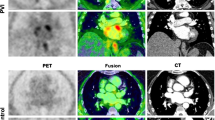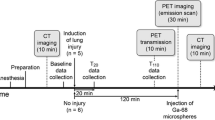Abstract
Purpose
The purpose of this study was to determine the effect of a synthetic tryptophan metabolite, tranilast [N-(3,4-dimethoxycinnamoyl)-anthranilic acid], on inflammatory and hemorrhagic areas after pulmonary radiofrequency ablation (RFA) in rabbits.
Materials and methods
Percutaneous RFA using a 17-gauge LeVeen electrode was performed in normal rabbit lungs. The rabbits were divided into tranilast-treated (300 mg/kg/day, orally) and control groups (n = 24/group). The effects of tranilast were evaluated using multidetector-row computed tomography (CT), histology, and immunohistochemistry immediately after RFA on days 1, 7, 14, and 28.
Results
Oral administration of tranilast significantly reduced the size of ablated lesions assessed using CT and histology on days 7 and 14. Furthermore, it reduced the hemorrhagic areas on day 7 and inflammatory areas on day 14, but did not affect the areas of coagulation necrosis on days 1, 7, 14, and 28. Immunohistochemical analysis showed an increase in the ratio of CD163-positive macrophage areas to rabbit macrophage (RAM11)-positive pan-macrophage areas and a decrease in the number of nuclear factor-κB-positive nuclei and CD31-positive microvessels in the tranilast group on days 7 and/or 14.
Conclusions
The results suggest that tranilast modulates the repair process after pulmonary RFA through macrophage accumulation, suppression of inflammation, and angiogenesis.






Similar content being viewed by others
References
Gazelle GS, Goldberg SN, Solbiati L, Livraghi T. Tumor ablation with radio-frequency energy. Radiology. 2000;217:633–46.
Simon CJ, Dupuy DE, DiPetrillo TA, Safran HP, Grieco CA, Ng T, et al. Pulmonary radiofrequency ablation: long-term safety and efficacy in 153 patients. Radiology. 2007;243:268–75.
Kelekis AD, Thanos L, Mylona S, Ptohis N, Malagari K, Nikita A, et al. Percutaneous radiofrequency ablation of lung tumors with expandable needle electrodes: current status. Eur Radiol. 2006;16:2471–82.
Wolf FJ, Grand DJ, Machan JT, Dipetrillo TA, Mayo-Smith WW, Dupuy DE. Microwave ablation of lung malignancies: effectiveness, CT findings, and safety in 50 patients. Radiology. 2008;247:871–9.
Beland MD, Wasser EJ, Mayo-Smith WW, Dupuy DE. Primary non-small cell lung cancer: review of frequency, location, and time of recurrence after radiofrequency ablation. Radiology. 2010;254:301–7.
Okuma T, Matsuoka T, Yamamoto A, Oyama Y, Hamamoto S, Toyoshima M, et al. Determinants of local progression after computed tomography-guided percutaneous radiofrequency ablation for unresectable lung tumors: 9-year experience in a single institution. Cardiovasc Interv Radiol. 2010;33:787–93.
Hiraki T, Sakurai J, Tsuda T, Gobara H, Sano Y, Mukai T, et al. Risk factors for local progression after percutaneous radiofrequency ablation of lung tumors: evaluation based on a preliminary review of 342 tumors. Cancer. 2006;107:2873–80.
Giraud P, Antoine M, Larrouy A, Milleron B, Callard P, De Rycke Y, et al. Evaluation of microscopic tumor extension in non-small-cell lung cancer for three-dimensional conformal radiotherapy planning. Int J Radiat Oncol Biol Phys. 2000;48:1015–24.
Abtin FG, Eradat J, Gutierrez AJ, Lee C, Fishbein MC, Suh RD. Radiofrequency ablation of lung tumors: imaging features of the postablation zone. Radiographics. 2012;32:947–69.
Okuma T, Matsuoka T, Okamura T, Wada Y, Yamamoto A, Oyama Y, et al. 18F-FDG small-animal PET for monitoring the therapeutic effect of CT-guided radiofrequency ablation on implanted VX2 lung tumors in rabbits. J Nucl Med. 2006;47:1351–8.
Azuma H, Banno K, Yoshimura T. Pharmacological properties of N-(3′,4′-dimethoxycinnamoyl) anthranilic acid (N-5′), a new anti-atopic agent. Br J Pharmacol. 1976;58:483–8.
Koda A, Nagai H, Watanabe S, Yanagihara Y, Sakamoto K. Inhibition of hypersensitivity reactions by a new drug, N(3′,4′-dimethoxycinnamoyl) anthranilic acid (N-5′). J Allergy Clin Immunol. 1976;57:396–407.
Platten M, Ho PP, Youssef S, Fontoura P, Garren H, Hur EM, et al. Treatment of autoimmune neuroinflammation with a synthetic tryptophan metabolite. Science. 2005;310:850–5.
Chikaraishi A, Hirahashi J, Takase O, Marumo T, Hishikawa K, Hayashi M, et al. Tranilast inhibits interleukin-1beta-induced monocyte chemoattractant protein-1 expression in rat mesangial cells. Eur J Pharmacol. 2001;427:151–8.
Shimizu T, Kimura T, Funahashi T, Watanabe K, Ho IK, Yamamoto I. Displacement of opioid receptor binding ligands from the rat brain by N3-(2′,5′-dimethoxyphenacyl) arabinofuranosyluracil. Res Commun Mol Pathol Pharmacol. 2005;117–118:105–13.
Sata M, Takahashi A, Tanaka K, Washida M, Ishizaka N, Ako J, et al. Mouse genetic evidence that tranilast reduces smooth muscle cell hyperplasia via a p21(WAF1)-dependent pathway. Arterioscler Thromb Vasc Biol. 2002;22:1305–9.
Isaji M, Nakajoh M, Naito J. Selective inhibition of collagen accumulation by N-(3,4-dimethoxycinnamoyl)anthranilic acid (N-5′) in granulation tissue. Biochem Pharmacol. 1987;36:469–74.
Isaji M, Miyata H, Ajisawa Y, Takehana Y, Yoshimura N. Tranilast inhibits the proliferation, chemotaxis and tube formation of human microvascular endothelial cells in vitro and angiogenesis in vivo. Br J Pharmacol. 1997;122:1061–6.
Matsumura T, Kugiyama K, Sugiyama S, Ota Y Y, Doi H, Ogata N, et al. Suppression of atherosclerotic development in Watanabe heritable hyperlipidemic rabbits treated with an oral antiallergic drug, tranilast. Circulation. 1999;99:919–24.
Fukuyama J, Ichikawa K, Miyazawa K, Hamano S, Shibata N, Ujiie A. Tranilast suppresses intimal hyperplasia in the balloon injury model and cuff treatment model in rabbits. Jpn J Pharmacol. 1996;70:321–7.
Kuroki M, Nakada H, Yamashita A, Sawaguchi A, Uchino N, Sato S, et al. Loss of cellular viability in areas of ground-glass opacity on computed tomography images immediately after pulmonary radiofrequency ablation in rabbits. Jpn J Radiol. 2012;30:323–30.
Tominaga J, Miyachi H, Takase K, Matsuhashi T, Yamada T, Sato A, et al. Time-related changes in computed tomographic appearance and pathologic findings after radiofrequency ablation of the rabbit lung: preliminary experimental study. J Vasc Interv Radiol. 2005;16:1719–26.
Yamamoto A, Nakamura K, Matsuoka T, Toyoshima M, Okuma T, Oyama Y, et al. Radiofrequency ablation in a porcine lung model: correlation between CT and histopathologic findings. AJR Am J Roentgenol. 2005;185:1299–306.
Komohara Y, Hirahara J, Horikawa T, Kawamura K, Kiyota E, Sakashita N, et al. AM-3K, an anti-macrophage antibody, recognizes CD163, a molecule associated with an anti-inflammatory macrophage phenotype. J Histochem Cytochem. 2006;54:763–71.
Yamashita A, Matsuda S, Matsumoto T, Moriguchi-Goto S, Takahashi M, Sugita C, et al. Thrombin generation by intimal tissue factor contributes to thrombus formation on macrophage-rich neointima but not normal intima of hyperlipidemic rabbits. Atherosclerosis. 2009;206:418–26.
Higaki F, Okumura Y, Sato S, Hiraki T, Gobara H, Mimura H, et al. Preliminary retrospective investigation of FDG-PET/CT timing in follow-up of ablated lung tumor. Ann Nucl Med. 2008;22:157–63.
Lee JM, Jin GY, Goldberg SN, Lee YC, Chung GH, Han YM, et al. Percutaneous radiofrequency ablation for inoperable non-small cell lung cancer and metastases: preliminary report. Radiology. 2004;230:125–34.
Komatsu H, Kojima M, Tsutsumi N, Hamano S, Kusama H, Ujiie A, et al. Mechanism of inhibitory action of tranilast on the release of slow reacting substance of anaphylaxis (SRS-A) in vitro: effect of tranilast on the release of arachidonic acid and its metabolites. Jpn J Pharmacol. 1988;46:53–60.
Komatsu H, Kojima M, Tsutsumi N, Hamano S, Kusama H, Ujiie A, et al. Study of the mechanism of inhibitory action of tranilast on chemical mediator release. Jpn J Pharmacol. 1988;46:43–51.
Martin-Ventura JL, Madrigal-Matute J, Martinez-Pinna R, Ramos-Mozo P, Blanco-Colio LM, Moreno JA, et al. Erythrocytes, leukocytes and platelets as a source of oxidative stress in chronic vascular diseases: detoxifying mechanisms and potential therapeutic options. Thromb Haemost. 2012;108:435–42.
Tugal D, Liao X, Jain MK. Transcriptional control of macrophage polarization. Arterioscler Thromb Vasc Biol. 2013;33:1135–44.
Oyama Y, Nakamura K, Matsuoka T, Toyoshima M, Yamamoto A, Okuma T, et al. Radiofrequency ablated lesion in the normal porcine lung: long-term follow-up with MRI and pathology. Cardiovasc Interv Radiol. 2005;28:346–53.
Wright JG, Christman JW. The role of nuclear factor kappa B in the pathogenesis of pulmonary diseases: implications for therapy. Am J Respir Med. 2003;2:211–9.
Spiecker M, Lorenz I, Marx N, Darius H. Tranilast inhibits cytokine-induced nuclear factor kappaB activation in vascular endothelial cells. Mol Pharmacol. 2002;62:856–63.
Kosuga K, Tamai H, Ueda K, Hsu YS, Ono S, Tanaka S, et al. Effectiveness of tranilast on restenosis after directional coronary atherectomy. Am Heart J. 1997;134:712–8.
Ohri CM, Shikotra A, Green RH, Waller DA, Bradding P. The tissue microlocalisation and cellular expression of CD163, VEGF, HLA-DR, iNOS, and MRP 8/14 is correlated to clinical outcome in NSCLC. PLoS One. 2011;6:e21874.
Carus A, Ladekarl M, Hager H, Pilegaard H, Nielsen PS, Donskov F. Tumor-associated neutrophils and macrophages in non-small cell lung cancer: no immediate impact on patient outcome. Lung Cancer. 2013;81:130–7.
Acknowledgments
This research was supported in part by a Grants-in-Aid for Scientific Research in Japan (Nos. 19790885 H.N., 23790410, 25460440 A.Y., 23390084 Y.A.). We are most grateful to Ms. Kyoko Ohashi, Ms. Ritsuko Sotomura, Ms. Yukiko Motoura, Ms. Tomoko Kawanami, Ms. Takako Sakamoto and Mr. Minoru Shiraishi for their technical assistance.
Conflict of interest
None.
Author information
Authors and Affiliations
Corresponding author
About this article
Cite this article
Nakada, H., Yamashita, A., Kuroki, M. et al. A synthetic tryptophan metabolite reduces hemorrhagic area and inflammation after pulmonary radiofrequency ablation in rabbit nonneoplastic lungs. Jpn J Radiol 32, 145–154 (2014). https://doi.org/10.1007/s11604-014-0282-4
Received:
Accepted:
Published:
Issue Date:
DOI: https://doi.org/10.1007/s11604-014-0282-4




